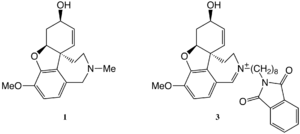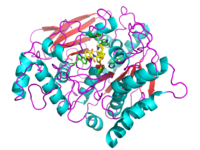COMPLEX OF TcAChE WITH BIS-ACTING GALANTHAMINE DERIVATIVE
(see also 1W6R, 1W76, and AChE bivalent inhibitors (Part II))
Biological Context
Alzheimer's disease is a disorder that attacks the central nervous system through progressive degeneration of its neurons. Patients with this disease develop dementia which becomes more severe as the disease progresses. It was suggested that symptoms of Alzheimer's disease are caused by a decrease in the activity of cholinergic neocortical and hippocampal neurons. Treatment for Alzheimer's disease by acetylcholine (ACh) precursors and cholinergic agonists was ineffective or caused side effects. The enzyme acetylcholinesterase (AChE) hydrolyses ACh, resulting in termination of cholinergic neurotransmission. Therefore, compounds which inhibit AChE might significantly increase the levels of ACh depleted by Alzheimer's disease. Galanthamine (1; GAL; Reminyl) is an AChE inhibitor and it is currently used for paliative therapy of Alzheimer's disease. The X-ray structure of Torpedo californica AChE (TcAChE) in complex with a bivalent galanthamine iminium derivative (3) was determined at 2.15 Å.

Structural Details
The bis-acting compound 3, is based on the parent compound (colored red), with an additional (8 carbons, yellow), and a (blueviolet). 3 has a higher affinity for AChE than that of GAL, showing a 100-fold smaller IC50. This could be explained by the fact that the AChE consists of two binding subsites. One is the "catalytic anionic site" (CAS), which is adjacent to the (orange). (cyan) is situated at the second binding subsite, termed the "peripheral anionic site" (PAS), ~14 Å from the CAS. Therefore, the ligands that will interact with both of these subsites, are expected to be more potent AChE inhibitors. One of the ways to produce such ligands is to combine two active substances in one compound. If it is spatially needed, these moieties could be separated by an alkyl linker with suitable length. In our case these two substances are the GAL and phthalimido moieties connected by an 8-carbon linker.
A comparison between the in complex with Torpedo californica AChE (TcAChE) and the structure (1dx6) shows an identical binding mode of the GAL-moiety (transparent red) of compound 3 to that of GAL alone (blue) at the CAS. The PEG molecule (gray) is located at the active site of galanthamine/TcAChE structure. The alkyl linker spans the active-site gorge and phthalimido moiety of the compound 3 is situated near the Trp279 at the PAS. Compound 3 has greater affinity to TcAChE than GAL. This can be explained by the increased number of interactions between compound 3 (which interacts not only with residues within CAS but also within PAS) and TcAChE in comparison to GAL. The binding mode of the (compound 5; cyan) with TcAChE (1w6r) is also identical to that of GAL itself. The main structural change is side-chain movement of Phe330 (plum) in the GAL iminium derivative/TcAChE complex, in comparison to that of GAL. The presence of (blue) in this compound causes this structural change and slightly decreases affinity of this compound to TcAChE in comparison to GAL itself.
About this Structure
1W4L is a Single protein structure of sequence from Torpedo californica. Full crystallographic information is available from OCA.
Additional Resources
For additional information, see: Alzheimer's Disease


